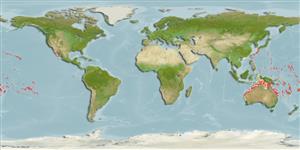>
Holocentriformes (Squirrelfishes, soldierfishes) >
Holocentridae (Squirrelfishes, soldierfishes) > Holocentrinae
Etymology: Sargocentron: Greek, sargos = sargus + Greek, kentron = sting (Ref. 45335).
Environment: milieu / climate zone / depth range / distribution range
Ecologia
marinhas associadas(os) a recifes; intervalo de profundidade 10 - 45 m (Ref. 30874). Tropical
Indo-Pacific: Christmas Island in the eastern Indian Ocean to Australia eastward to Fiji and Samoa. Recently recorded from the Chesterfield Islands (Ref. 11897).
Tamanho / Peso / Idade
Maturity: Lm ? range ? - ? cm
Max length : 20.0 cm TL macho/indeterminado; (Ref. 90102)
Espinhos dorsais (total) : 11; Raios dorsais moles (total) : 12 - 14; Espinhos anais: 4; Raios anais moles: 8 - 9. Body light red to orange-red with narrow darker red stripes separating scale rows; white streak on head absent (except beneath maxilla); 4-5 oblique scale rows on cheek; body depth 2.65-2.95 in SL; head length (HL) 2.55-2.8 in SL; snout length 3.8-4.15 in HL; interorbital width 5.25-6.35 in HL; dorsal head profile slightly convex; maxilla extending to between verticals at front edge of iris and center of eye; upper jaw length 2.35-2.6 in HL; rounded anterior end of nasal bone; medial margin of nasal bone without retrorse spine; moderately large nasal fossa without spines; upper surface of nasal bone between nasal fossa and premaxillary groove edge with a retrorse spine; 2 opercular spines, with the lower 1/2-3/4 length of the upper; preopercular spine 4.8-6.35 HL; spinules on posterior margin of preopercle 17 (3.3 cm SL specimen), 19 (4.9 cm), 26 (5.3 cm), 30-36 (6.4-8.1 cm); 4th to 6th dorsal spines subequal, the longest, 2.3-2.65 in HL; 3rd anal spine 1.5-1.95 in HL; broadly rounded caudal-fin lobes (Ref. 27370).
Nocturnal. Minimum depth reported taken from Ref. 11897. Solitary and cryptic, found in outer reef slopes of oceanic islands, mainly in the South Pacific (Ref 90102).
Life cycle and mating behavior
Maturidade | Reprodução | Desova | Ovos | Fecundidade | Larvas
Randall, J.E., 1998. Revision of the Indo-Pacific squirrelfishes (Beryciformes: Holocentridae: Holocentrinae) of the genus Sargocentron, with descriptions of four new species. Indo-Pac. Fish. (27):105 p. (Ref. 27370)
Categoria na Lista Vermelha da IUCN (Ref. 130435: Version 2024-1)
Ameaça para o homem
Harmless
Utilização humana
Pescarias: sem interesse
Ferramentas
Relatórios especiais
Descarregue XML
Fontes da internet
Estimates based on models
Preferred temperature (Ref.
123201): 23.1 - 28.7, mean 27.2 °C (based on 154 cells).
Phylogenetic diversity index (Ref.
82804): PD
50 = 0.5000 [Uniqueness, from 0.5 = low to 2.0 = high].
Bayesian length-weight: a=0.01660 (0.00788 - 0.03495), b=2.97 (2.80 - 3.14), in cm total length, based on LWR estimates for this Genus-body shape (Ref.
93245).
Nível Trófico (Ref.
69278): 4.1 ±0.68 se; based on food items.
Resiliência (Ref.
120179): Elevada, tempo mínimo de duplicação da população menor que 15 meses (Preliminary K or Fecundity.).
Fishing Vulnerability (Ref.
59153): Low vulnerability (10 of 100).
Nutrients (Ref.
124155): Calcium = 64.6 [24.5, 255.3] mg/100g; Iron = 0.545 [0.212, 1.665] mg/100g; Protein = 18.8 [17.6, 20.0] %; Omega3 = 0.163 [0.070, 0.380] g/100g; Selenium = 31.5 [17.3, 65.0] μg/100g; VitaminA = 82.6 [29.8, 245.6] μg/100g; Zinc = 1.75 [0.72, 3.35] mg/100g (wet weight);
